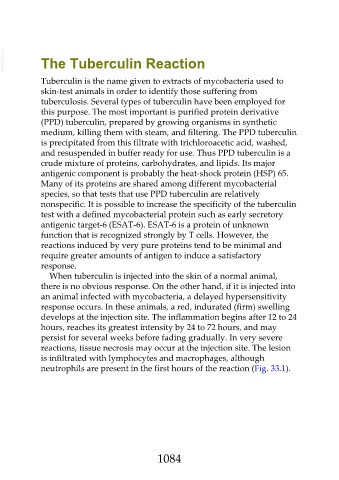Page 1084 - Veterinary Immunology, 10th Edition
P. 1084
VetBooks.ir The Tuberculin Reaction
Tuberculin is the name given to extracts of mycobacteria used to
skin-test animals in order to identify those suffering from
tuberculosis. Several types of tuberculin have been employed for
this purpose. The most important is purified protein derivative
(PPD) tuberculin, prepared by growing organisms in synthetic
medium, killing them with steam, and filtering. The PPD tuberculin
is precipitated from this filtrate with trichloroacetic acid, washed,
and resuspended in buffer ready for use. Thus PPD tuberculin is a
crude mixture of proteins, carbohydrates, and lipids. Its major
antigenic component is probably the heat-shock protein (HSP) 65.
Many of its proteins are shared among different mycobacterial
species, so that tests that use PPD tuberculin are relatively
nonspecific. It is possible to increase the specificity of the tuberculin
test with a defined mycobacterial protein such as early secretory
antigenic target-6 (ESAT-6). ESAT-6 is a protein of unknown
function that is recognized strongly by T cells. However, the
reactions induced by very pure proteins tend to be minimal and
require greater amounts of antigen to induce a satisfactory
response.
When tuberculin is injected into the skin of a normal animal,
there is no obvious response. On the other hand, if it is injected into
an animal infected with mycobacteria, a delayed hypersensitivity
response occurs. In these animals, a red, indurated (firm) swelling
develops at the injection site. The inflammation begins after 12 to 24
hours, reaches its greatest intensity by 24 to 72 hours, and may
persist for several weeks before fading gradually. In very severe
reactions, tissue necrosis may occur at the injection site. The lesion
is infiltrated with lymphocytes and macrophages, although
neutrophils are present in the first hours of the reaction (Fig. 33.1).
1084

